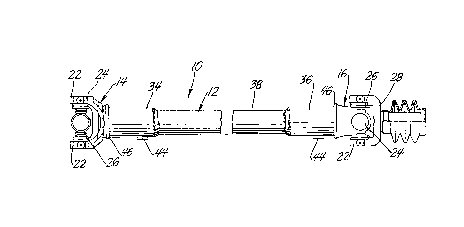Some of the information on this Web page has been provided by external sources. The Government of Canada is not responsible for the accuracy, reliability or currency of the information supplied by external sources. Users wishing to rely upon this information should consult directly with the source of the information. Content provided by external sources is not subject to official languages, privacy and accessibility requirements.
Any discrepancies in the text and image of the Claims and Abstract are due to differing posting times. Text of the Claims and Abstract are posted:
| (12) Patent Application: | (11) CA 2242154 |
|---|---|
| (54) English Title: | CONSTRUCTION AND METHOD OF MAKING PROP SHAFT HAVING ENLARGED END SECTIONS |
| (54) French Title: | CONSTRUCTION ET METHODE DE FABRICATION D'UN ARBRE DE TRANSMISSION A SECTIONS D'EXTREMITE ELARGIES |
| Status: | Deemed Abandoned and Beyond the Period of Reinstatement - Pending Response to Notice of Disregarded Communication |
| (51) International Patent Classification (IPC): |
|
|---|---|
| (72) Inventors : |
|
| (73) Owners : |
|
| (71) Applicants : |
|
| (74) Agent: | SMART & BIGGAR LP |
| (74) Associate agent: | |
| (45) Issued: | |
| (22) Filed Date: | 1998-07-03 |
| (41) Open to Public Inspection: | 1999-01-07 |
| Availability of licence: | N/A |
| Dedicated to the Public: | N/A |
| (25) Language of filing: | English |
| Patent Cooperation Treaty (PCT): | No |
|---|
| (30) Application Priority Data: | ||||||
|---|---|---|---|---|---|---|
|
An automotive prop shaft assembly particularly suited for coupling
a transfer case to the front axle drive components comprises a tubular drive shaft
having an initial uniform inner diameter relatively smaller than the outer diameter
of a pair of forged insert yokes to be attached to the ends of the shaft. A section of
each end of the tube is enlarged so that its inner diameter is sized to receive the
yokes into the ends of the tube with an interference fit. The shaft and yokes are
then welded together and weights fixed to the end sections to correct for imbalance.
Ensemble d'arbre de transmission de véhicule automobile conçu en particulier pour coupler une boîte de transfert aux composants d'un essieu avant. Cet ensemble est constitué d'un arbre d'entraînement tubulaire offrant un diamètre interne initial uniforme et relativement plus faible que le diamètre extérieur d'une paire de fourches constituée d'une pièce rapportée forgée à fixer aux extrémités de l'arbre. Une section de chaque extrémité du tube est élargie de manière à ce que son diamètre interne ait la dimension voulue pour recevoir les fourches dans les extrémités du tube, en les ajustant par serrage. L'arbre et les fourches sont ensuite réunis par soudage et l'on fixe des poids aux sections d'extrémité pour corriger tout balourd.
Note: Claims are shown in the official language in which they were submitted.
Note: Descriptions are shown in the official language in which they were submitted.

2024-08-01:As part of the Next Generation Patents (NGP) transition, the Canadian Patents Database (CPD) now contains a more detailed Event History, which replicates the Event Log of our new back-office solution.
Please note that "Inactive:" events refers to events no longer in use in our new back-office solution.
For a clearer understanding of the status of the application/patent presented on this page, the site Disclaimer , as well as the definitions for Patent , Event History , Maintenance Fee and Payment History should be consulted.
| Description | Date |
|---|---|
| Inactive: IPC from MCD | 2006-03-12 |
| Inactive: IPC from MCD | 2006-03-12 |
| Application Not Reinstated by Deadline | 2002-07-03 |
| Time Limit for Reversal Expired | 2002-07-03 |
| Deemed Abandoned - Failure to Respond to Maintenance Fee Notice | 2001-07-03 |
| Application Published (Open to Public Inspection) | 1999-01-07 |
| Classification Modified | 1998-10-14 |
| Inactive: First IPC assigned | 1998-10-14 |
| Inactive: IPC assigned | 1998-10-14 |
| Filing Requirements Determined Compliant | 1998-09-15 |
| Inactive: Filing certificate - No RFE (English) | 1998-09-15 |
| Application Received - Regular National | 1998-09-09 |
| Abandonment Date | Reason | Reinstatement Date |
|---|---|---|
| 2001-07-03 |
The last payment was received on 2000-06-21
Note : If the full payment has not been received on or before the date indicated, a further fee may be required which may be one of the following
Patent fees are adjusted on the 1st of January every year. The amounts above are the current amounts if received by December 31 of the current year.
Please refer to the CIPO
Patent Fees
web page to see all current fee amounts.
| Fee Type | Anniversary Year | Due Date | Paid Date |
|---|---|---|---|
| Application fee - standard | 1998-07-03 | ||
| Registration of a document | 1998-07-03 | ||
| MF (application, 2nd anniv.) - standard | 02 | 2000-07-04 | 2000-06-21 |
Note: Records showing the ownership history in alphabetical order.
| Current Owners on Record |
|---|
| AMERICAN AXLE & MANUFACTURING INC. |
| Past Owners on Record |
|---|
| MARK S. BARRETT |
| THOMAS J. OLDENBURG |